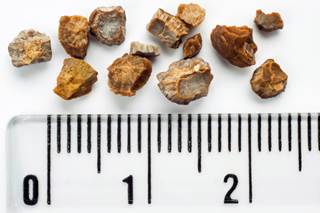Search for dialysis centres here
 Log in to explore the world's most comprehensive database of dialysis centres for free!
Log in to explore the world's most comprehensive database of dialysis centres for free!
| Tamsulosin Improves Passage of Large Ureteric Stones - Renal and Urology News |
 |
 |
July 30, 2015
 Study demonstrates a benefit in patients with distal ureteric stones 5–10 mm in diameter. Medical expulsive therapy using tamsulosin aids passage of distal ureteric stones 5–10 mm in diameter, according to a double-blind, placebo-controlled, randomized trial. Australian investigators led by Jeremy S. Furyk, MBBS, of the Townsville Hospital in Queensland, recruited 403 patients from 5 emergency departments who had distal ureteric stones 10 mm or smaller as shown on computed tomography (CT). Patients received the ?-blocker tamsulosin (0.4 mg) or identical placebo pills for up to 28 days, the maximum time for spontaneous stone passage. Investigators, treating physicians, and patients were blinded to the pills received. Each week, researchers contacted patients to ask about pain symptoms and adverse effects, such as dizziness or palpitations. Pain medication was given at the discretion of the treating physician. After 28 days, patients had a limited CT to determine stone passage. According to results published in the Annals of Emergency Medicine, stone passage occurred in 87% of tamsulosin patients and 82% of placebo patients overall, a non-significant difference between the groups. Among those with stones 5–10 mm in diameter, however, 83% experienced stone passage with tamsulosin compared with 61% with placebo, a between-group difference that was significant. The researchers calculated that 4.5 patients would need to be treated to see an effect. Dr. Furyk's group observed no significant differences between the treatment arms in the need for urologic interventions, time to stone passage, pain, or analgesia requirements. The groups also did not differ significantly with respect to adverse events, which were generally mild. “For patients with small kidney stones, time seems to be the one sure cure,” Dr. Furyk stated in a release. “However, when treating patients with large kidney stones, emergency physicians should definitely consider tamsulosin.” Guidelines have suggested “off-label” use of medical expulsive therapies for newly diagnosed stones less than 10 mm in diameter. Among the study limitations, the investigators noted that 17% of patients in each group did not have a follow-up CT. Treatment compliance was also problematic for both groups – a circumstance that may reflect actual practice. Sources
|
 Professional dialysis recruitment
Professional dialysis recruitment
